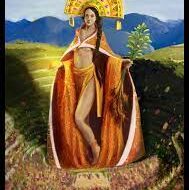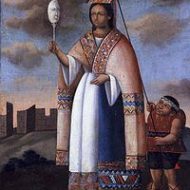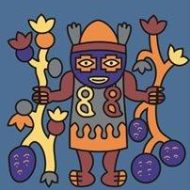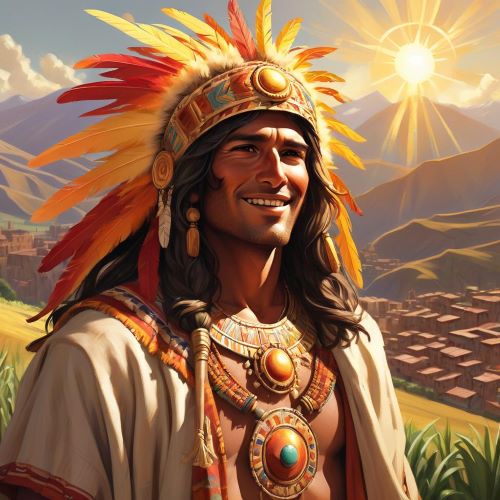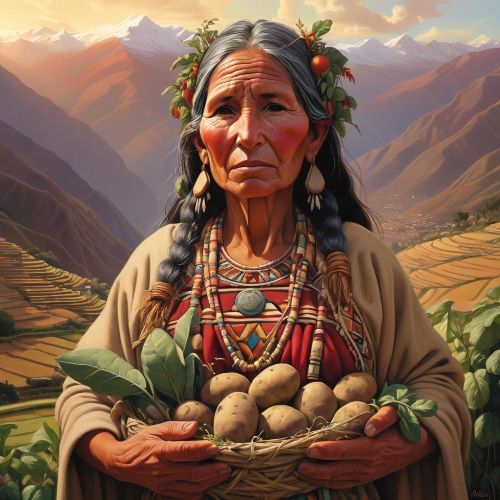Axomamma : The Potato Goddess of the Inca Civilization
Listen
At a glance
| Description | |
|---|---|
| Origin | Inca Mythology |
| Classification | Gods |
| Family Members | Pachamama (Mother) |
| Region | Bolivia, Ecuador, Columbia, Chile, Peru |
| Associated With | Potatoes |
Axomamma
Introduction
Axomamma is revered in Andean and Incan mythology as the goddess of potatoes — one of the most essential crops for life in the highlands of South America. Her divine role reflects the centrality of the potato in the Inca diet, economy, and worldview. While maize was prestigious among elites, potatoes were the reliable lifeline for everyday survival, adaptable to harsh mountain climates and easily preserved as chuño for long-term food security.
As the Inca domesticated and cultivated a large variety of potatoes across the Andes, Axomamma became spiritually associated with their growth, abundance, and nourishment. Some traditions also suggest potatoes were placed with the dead to ensure that Axomamma’s blessing continued into the afterlife.
Physical Traits
Direct historical records about her anthropomorphic appearance are limited, but in folk tradition she is sometimes visualized wearing traditional Andean clothing and holding potato stalks or tubers in each hand.
More importantly, her presence was symbolized through conopas — specially chosen potatoes with unusual or human-like shapes. Families treated these sacred tubers with respect, believing Axomamma resided within them and could ensure a fertile harvest for the household.
Family
Axomamma is widely regarded as one of the daughters of Pachamama, the revered Earth Mother and guardian of all agriculture. While Axomamma watches over potato crops specifically, offerings and sacrifices made in her honour traditionally pass through Pachamama, who ultimately maintains balance between the land and its people. This familial connection places Axomamma within a broader Andean spiritual system, where each food source — from maize to coca — has a divine protector rooted in the earth’s generative power.
Other Names
Due to regional variations across the Andes, Axomamma is known by several different names, including Acsumama, Ajomama, Axo-Mama, Potato Mother and Potato Lady. Though the spellings and pronunciations shift between communities, all these names reaffirm her status as the divine protector of potato crops. It is also worth noting that some earlier or less-accurate sources mistakenly refer to her as male, but across traditional Andean beliefs she is consistently understood as a feminine deity, connected with fertility and nourishment.
Powers and Abilities
Axomamma’s powers are rooted in the practical needs of survival rather than in celestial or cosmic authority. She is believed to bless the land with strong, healthy and abundant potato harvests that can sustain families through harsh winters and unpredictable weather conditions. Her influence also extends to protecting potatoes from disease and supporting their long-lasting storage, ensuring a continuous food supply. Although she does not take part in major mythological events or shape the fate of the world like more prominent Inca deities, she holds a vital place in daily life — a divine presence in the soil, in the act of growing food and in the nourishment that keeps communities alive.
Modern Day Influence
While formal worship of Axomamma has faded over centuries of colonial disruption and cultural change, her legacy continues through enduring Andean values and agricultural practices. Potatoes remain a sacred crop in many communities, with offerings still made to Pachamama during planting and harvest seasons — a continuity of the spiritual principles once associated directly with Axomamma. Indigenous farmers also work to preserve native potato diversity in the Andes, a living testament to the reverence for this essential food. Cultural festivals and rituals tied to the agricultural calendar echo the spiritual identity she represents. Today, Axomamma stands as a symbol of resilience, gratitude and the recognition that even the most humble elements of daily life — like a potato — can carry profound cultural and mythic meaning.
Related Images
Sources
EarthStoriez. Bolivia: Myth, folklore and history of the potato. Retrieved from https://earthstoriez.com/bolivia-myth-folklore-potato-papa
Godchecker. AXO-MAMA – the Inca Goddess of Potatoes (Inca mythology). Retrieved from https://www.godchecker.com/inca-mythology/AXO-MAMA/?utm_source=shared
Halfbananas. “God of the week – Axomamma.” Posted July 29, 2016. Retrieved from https://halfbananas.com/2016/07/29/god-of-the-week-axomamma/
Wikipedia contributors. “Axomamma.” Wikipedia. Retrieved from https://en.wikipedia.org/wiki/Axomamma
de Haan, S. (2009). Potato diversity at height: Conservation in the Andes. International Potato Center.
Minelli, L. L. (2000). The Inca world: The development of pre-Columbian Peru. University of Oklahoma Press.
Pieterse, L. (2013). The potato: A global history of culture and survival. Global Food History Press.
Frequently Asked Questions
Who is the god of potatoes?
Axomamma, a deity linked to potatoes, was revered by the Inca civilization, situated in present-day Peru. She is recognized as one of the daughters of Pachamama, the mother of the earth.
How was Axomamma Worshipped?
The Incan goddess Axomamma, associated with potatoes, received worship through diverse rituals. In addition to cultivating and consuming potatoes, the Incas held them in high esteem, incorporating them into burial practices for the deceased. Many villages venerated a distinctively shaped potato, employing it in rituals to seek a bountiful harvest.
What did the Incas call potato?
The Incas called the potato “chuño.” Chuño, a freeze-dried potato product, has been traditionally crafted by Quechua and Aymara communities in Bolivia and Peru.
Who is the Incan god of potatoes?
Axomamma is the Incan deity associated with potatoes. She is considered a protector of potato crops and is often invoked for a good harvest.


